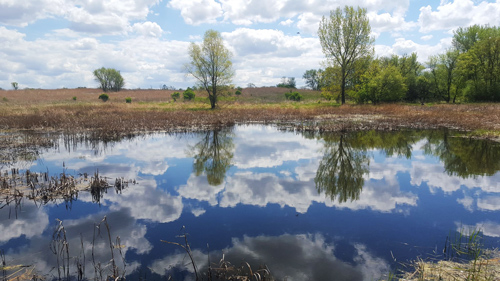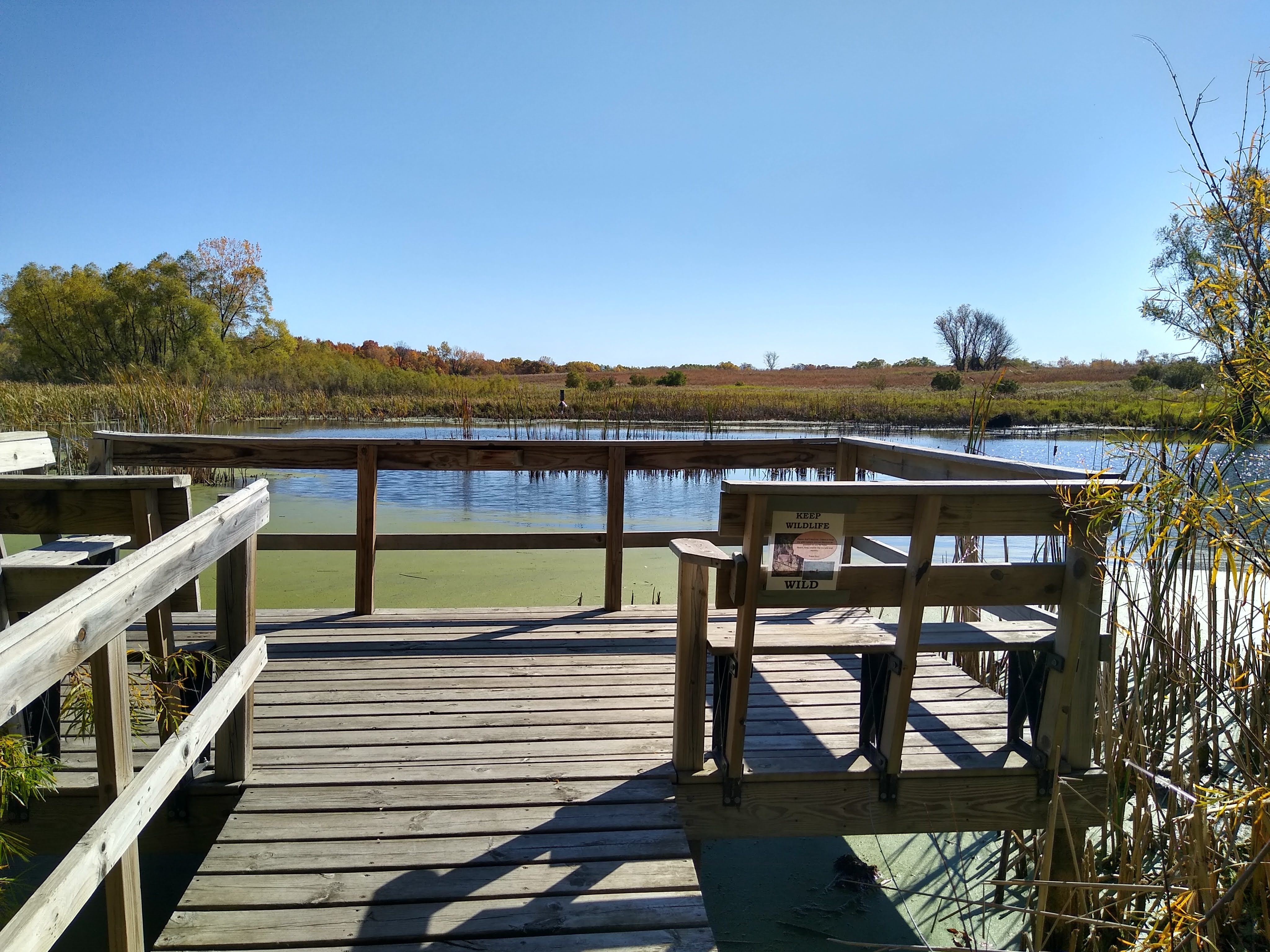We have a new facebook page. Like or Follow our page to keep up to date with our events.
Ponds

Turtle Pond
Turtle Pond is just a short walk down paved trails from the main parking lot. It is small and shallow and features a floating bridge straight across the middle. This pond is uniquely situated in our forest and is surrounded by trees on all sides which makes it somewhat of a refuge for the small creatures that live in it because it is less likely to attract birds like egrets, herons, and water fowl who feed on them.
Turtle Pond is thus named for the many turtles that can be seen sunning themselves in the warm months on the logs that protrude out of the water's surface. The pond could just as easily have been called "Frog Pond" as they are abundant as well. Chorus frogs, wood frogs, and leopard frogs are some of the species that fill the pond with their songs in spring and summer. When tadpoles grow legs and their tails begin to shrink frogs can be seen in the pond by the hundreds.
When you visit Turtle Pond, you'll likely notice the tiny green plants that cover the entire surface of the water, this is not algae, it's duckweed and it is a native and healthy part of the pond habitat. In and under the duckweed live the tiny and fascinating invertebrates that also call the pond home. School groups and summer campers enjoy laying on the bridge and using small dip nets to scoop out clumps of duckweed to put in a white tray filled with pond water so they can examine some of the pond creatures up close. Students regularly get to see water boatman, dragonfly larva, tadpoles, water beetles, and more.
Bottom line: Turtle Pond is a must-stop spot when visiting River Bend. It is close, convenient, accessible, and always a new surprise every time you visit.


Prairie Pond
Prairie Pond is the closest pond to the main parking lot and the Interpretive Center. The trails to reach it are gravel and are sometimes bumpy so it is somewhat less handicap accessible than Turtle Pond. Prairie Pond is situated in the middle of our prairie and spans far further than it appears at first glance as it extends into wetlands that cross the entire prairie. On the edge of the pond is a floating dock with benches for relaxing.
Prairie Pond attracts many wildlife visitors and residents. It is alive with red-winged blackbirds screeching at anyone and everyone in spring time as they mate and set up nests to raise their young. White-tailed deer visit this pond for its water and often cross it on their way through the prairie. The tall bulrushes, cattails, and other vegetation make it ideal for animals wishing to conceal their presence in the pond. Other animals that have been known to live in and raise their young in the pond are muskrats, Canada geese, wood ducks, mallards, and a variety of song birds.
Prairie Pond is the first of our ponds to dry out in summers without much rain and it usually remains that way until after the snow melts the following spring. In spring and through the majority of the summer frogs can be heard singing loudly from Prairie Pond, especially chorus frogs who are the first to sing after the warm up. Prairie Pond is a great place to visit and when the water is high enough, it is a fun place to use dip nets just like you do in Turtle Pond. It is always a relaxing place to sit and observe the pond's residents, the longer you observe, the more discoveries you will make.
Bottom line: Prairie Pond is a short, easy walk from the main parking lot and has lots of wildlife action in spring and summer. Mosquitoes tend to be less pesty here than at Turtle Pond. This pond is accessible via unpaved trails so it more difficult to get to for those with mobility issues.

Upper Pond
You will likely get your first glimpse of Upper Pond if you arrive at River Bend by our main road, Rustad Road, as the pond is adjascent to it. It is conveniently located just a short walk down the road from the upper parking lot and across Rustad Road from our waterfall. Much of the year the pond is visible from the road and the wildlife that visit it attract a lot of attention from motorists. To get the best view of the wildlife in and around Upper Pond we recommend you visit on foot the bank along Rustad Road and the small dock with benches just off the road.
Upper Pond is a beacon for just about any still-water-seeking animal that lives at or passes through River Bend. At least half-dozen different water birds have been known to raise their young on Upper Pond including regulars Canada geese, blue-winged teals, wood ducks, and mergansers. Spring and summer bird visitors to the pond include northern shovelers, great egrets, blue herons, American coots, eastern king birds, green herons, cedar waxwings, mud hens, pied-billed grebes, owls, swallows, and many more. Upper Pond is host to an amazing array of dragonfly and damselfly varieties during the summer months and fireflies can be spotted if you visit as the sun goes down. Deer are frequent visitors to this pond, too, and does with fawns are often seen eating and drinking at the pond. This pond is also home to amphibians and turtles, including the occasional snapping turtle.
Bottom Line: Upper Pond is an ideal location for wildlife photographers, drive-by nature enthusiasts, and birders. The pond is accessible from the road (mostly paved with a big gravel patch by this pond) and is about 500 feet from the nearest parking lot.

Other Ponds
River Bend is home to many other ponds that are exciting to visit especially in spring when they are visible and the animals that live in and around them are active. Read on for details of some notable "other" ponds and their locations.
Hidden Ponds
The hidden ponds are in the valley that runs between north Owl Trail and the Honor Point walk bridge. These picturesque little ponds, "hidden" in the woods are spring-fed and so don't dry up. Many interesting insects and water creatures live in these ponds, we've even found tiny fish in them! Students sometimes visit these ponds to study their creatures and water quality. These ponds are off-trail and not very accessible for anyone with mobility issues (think bushwhacking), although a few of them are close to the trail and you can reach them fairly easily through the sparce forest vegetation. To locate them follow North Owl trail downhill past the Kids in the Wild play area and then head south into the forest. Or, start at the Honor Point foot bridge and head north along the water that passes under it.
Amphitheater "Pond"
The pond right next to the Kay Janky Amphitheater is remarkable only due to its rusty orange color and the fact that swamp marigolds sometimes bloom there in the early spring. It's also not so much of a pond as a muddy puddle but, like the Hidden Ponds, is spring-fed and stays wet even when other ponds dry out.
Rabbit Trail & Dairy Lane Ponds
The ponds on Rabbit trail and Dairy Lane are actually parts of small streams that run through this low-lying area. Historically our land belonged to the Faribault Regional Center and the ponds were used as day trip destinations for residents. The ponds are now largely overgrown along their banks and have gone "back to nature". While the ponds' banks are not directly accessible, the ponds are visible from the trails and are great for wildlife hearing and viewing, especially painted and snapping turtles and frogs. The Rabbit trail ponds run perpendicular to the trail just south of the train underpass. The Dairy Lane ponds are visible from the two cement bridges north of the Straight River and south of the state's farm buildings. These ponds are far from our trail heads so be prepared for a few mile walk to get to them and back again; they are somewhat closer to the South Side entrance than the main entrance.
